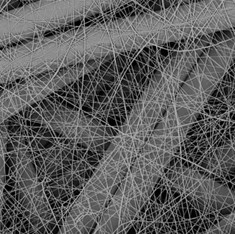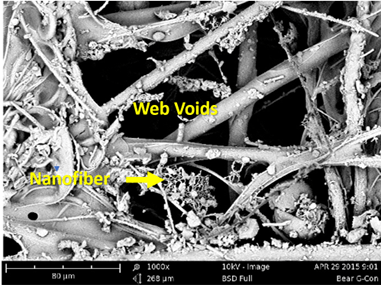New processes and proprietary polymers used with generating Braden Filtration’s PremierWeb™ nanofiber technology has addressed many of those performance properties and has successfully improved those nanofiber strength, flexibility and overall durability. Here are some key factors in the design improvements.
1. Mechanical Stability and Resistance
· Durability: Nanofibers need to withstand the mechanical stresses imposed during the filtration and pulse cleaning process. During the pulse cleaning process, the filter cartridge media experiences fluctuations in flow, air pressure, and particle impact. Higher durability of the nanofibers will facilitate greater structural integrity, preventing the fiber from degrading rapidly and maintain better efficiency over time.
2. Longevity and Cost-Effectiveness:
· Durability: A more durable filter cartridge made with a more resilient nanofiber layer will promote a longer lifespan. This durability contributes to cost-effectiveness by reducing the frequency of replacements, maintenance and associated downtime.
3. Flexibility for Efficient Filtration:
· Flexibility: The flexibility of nanofibers is crucial for efficient filtration. Flexibility allows the fibers to bend and adjust, ensuring a more effective capture of particles of various sizes. This adaptability enhances the filter’s overall performance by increasing the probability of particles being trapped on the surface of the filter medium.
4. Pulse Cleaning Mechanism
· Flexibility: In pulse-style filter cartridges, a cleaning mechanism is employed to remove accumulated particles. The nanofibers need to be flexible enough to respond to the high-pressure reverse pulse. Flexible nanofibers can more readily release particles on the filter surface maintaining the air filter’s ability to recover its porosity after cleaning.
5. High Surface Area and Efficiency:
· Flexibility: Nanofibers can be designed to have a high surface area, providing more opportunities for particles to be captured. This increased surface area contributes to higher filtration efficiency. The flexibility of nanofibers enables them to form intricate structures that enhance their overall effectiveness in capturing particles.
6. Adaptability to Dynamic Operating Conditions
· Durability and Flexibility: Industrial environments often have dynamic operating conditions, including changes in airflow, temperature, and particle concentrations. Durability and flexibility allow the filter to adapt to these variations, ensuring consistent and reliable performance over time.
The polymer chemistry and application processes exhibit the performance in durability and flexibility of nanofibers in a pulse-style filter cartridge application. Both being essential for maintaining structural integrity, improving filtration efficiency, and ensuring longevity in diverse and demanding operating conditions. These characteristics contribute to the overall effectiveness and cost-effectiveness of air filtration systems in various industrial and commercial applications.




